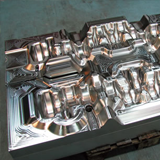
WORKNC – Perfect for the hard machining of heavy forging dies
Company Credentials
Bharat Forge Kilsta in Sweden has been using WORKNC CADCAM software to manufacture its forging tools since 1998. The company is part of the $1.5 billion Kalyani Group and it specializes in heavy crankshafts, front axle beams and steering knuckles for trucks and buses for companies such as Volvo, Renault, Mack, Scania, Iveco and Ford. The company has a venerable history and can trace its roots back to 1646, while in 1894 the company was owned by Alfred Nobel. It is now the biggest supplier of front axle beams and the second largest supplier of heavy crankshafts in Europe.
“Since we purchased the system in 1998 we have made thousands of dies and we have only ever had one mark in one die – it is exceptionally reliable.”
Dick Lindqvist, Bharat Forge Kilsta
Dick Lindqvist from Bharat Forge Kilsta says, “Back in 1989, all our tooling was made by hand without any CAM system. By 1990, we had introduced CAD and CAM and we were producing electrodes for die sinking as milling directly into steel was too difficult as the software left marks on the part, which we had to weld and then mill again.”
The perfect CAD CAM
In 1997 the first WORKNC demonstration showed that machining directly into hard material was possible and could be achieved without any gouges or other machining marks. Dick Lindqvist adds, “We looked at a lot of CAM systems and shortlisted three. We borrowed WORKNC and proved to ourselves how simple it is to use, how easily it can mill cavities with lots of surface features, and the high quality of the toolpaths it produces.”
Now Bharat Forge Kilsta has six WORKNC licenses floating across seven workstations programming 11 CNC machines. Because the software is used on the shop floor, ease of use is important. Dick Lindqvist says, “Models come from our Unigraphics CAD server in IGES format. Translation into WORKNC is very reliable, enabling our operators to program directly on the latest design data. WORKNC is highly intuitive, so if an operator has not written a program for a little while, he can pick the software up again without any difficulty.”
High quality toolpaths are also very important. “Since we purchased the system in 1998 we have made thousands of dies and we have only ever had one mark in one die – it is exceptionally reliable.”
3 and 3+2 axes HSM in WORKNC
A finishing lower die for a crankshaft can weigh over 1700 kg, before machining starts, and in some cases requires around 670 kg of material to be removed to produce the completed die, while an upper crankshaft tool can be over 1400kg with up to 390 kg of material to be removed. On average around 35% of the material is milled away. These tools are destined for use in the company’s 16,000 ton press and it produces around 100 pairs of front axle and crankshaft tools each year. The heavy machining involved currently precludes the use of 5-axis technology as these machines have insufficient rigidity at the moment. 3 and 3+2 axis machining programmed with WORKNC has reduced lead times from 12 weeks in 1989, when all the processes were by hand, and 6 weeks, when the dies were produced by EDM, to just 2 weeks using high-speed machining techniques with WORKNC.
Reliability enables lights out machining
Rough machining usually starts with a 52x6mm diameter tool and goes down in steps to a 16mm diameter ball, with finishing operations going down to a 6mm diameter ball. High-speed machining techniques are used throughout using WORKNC’s Global Roughing and Re-roughing, and Z-level and optimized Z-level finishing strategies. Dick Lindqvist says, “We carry out roughing during the day as we take heavy cuts 1.5 to 2mm deep with a 28mm overlap on the 52mm diameter tools and if there is going to be a problem with tool wear it will be in the roughing operations. Semifinishing operations can take up to 10 hours and finishing operations a further 10 hours enabling them to be very nearly completed overnight, thanks to the reliability of WORKNC.”
Particularly difficult is the machining of the upper and lower trimmer dies. A welded Stellite bead has to be machined to a sharp edge to cut flash from the forging. Dick Lindqvist adds, “The trimming tools operate at about 1140°C so the trimming edge needs to be particularly sharp and hard. We use WORKNC Curve Re-machining and Tangent to a Curve strategies to achieve the sharp edge, with tools as small as 6mm diameter.”
Good product, good service
WORKNC produces high quality surface finishes and efficient toolpaths. Dick Lindqvist says, “Sometimes we have to grind the surface to produce texture as the finish created by WORKNC is too smooth. We need to do this to ensure the forging does not slip in the die during manufacture. The remachining in WORKNC eliminates wasted movement and there is no air cutting to speak of. Other systems we have looked at are not as good.” He concludes, “We have been working with the WORKNC team for a long time now and we find that the service is first class with rapid response to any queries we have. Overall, WORKNC is very important to us as all our forging tools rely on it for the production of toolpaths.”
About the Company
Name: Bharat Forge Kilsta
Web: www.bfkilsta.com
Benefits Achieved
- Dramatically reduced machining times
- Overnight production due to confidence in WorkNc
- High quality finish
Comments
“Since we purchased the system in 1998 we have made thousands of dies and we have only ever had one mark in one die – it is exceptionally reliable.”
Dick Lindqvist, Bharat Forge Kilsta









